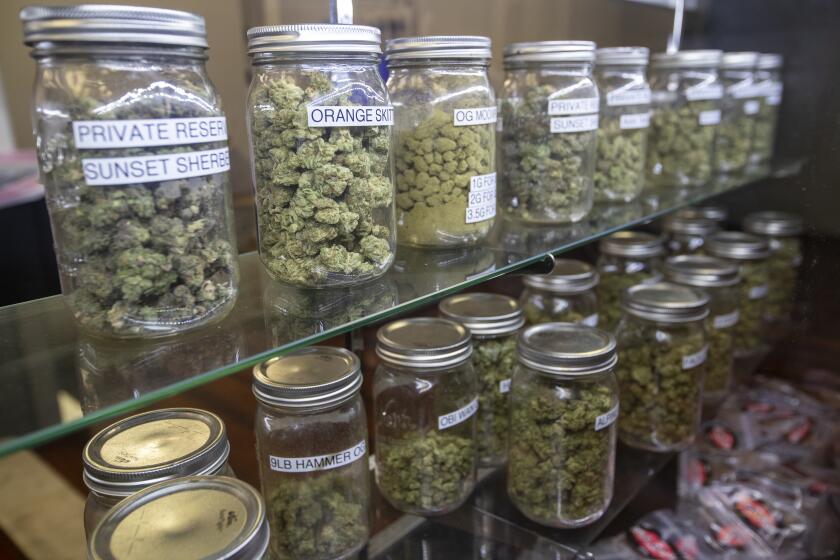Doctors are top source of prescription drugs for chronic abusers
Doctors are fueling the nation’s prescription drug epidemic and represent the primary source of narcotic painkillers for chronic abusers, according to a new government study.
The finding challenges a widely held belief that has long guided policymakers: That the epidemic is caused largely by abusers getting their drugs without prescriptions, typically from friends and family.
Dr. Tom Frieden, director of the Centers for Disease Control and Prevention, which conducted the study, said the research showed the need for greater focus on doctors who are “problem prescribers.”
The study, published Monday by the Journal of the American Medical Assn., echoes a 2012 Times investigation that found drugs prescribed by doctors caused or contributed to nearly half of the prescription overdose deaths in Southern California in recent years. The Times also revealed that authorities were failing to mine a rich database of prescribing records to identify and stop reckless prescribers.
Frieden said the new study, appearing in JAMA’s Internal Medicine journal, along with The Times investigation and a second JAMA article on the widespread use of narcotic painkillers in Tennessee, all showed that physician prescribing was a key contributor to the crisis of addiction and overdose that has continued to mount since the CDC declared it an epidemic in 2011.
Prescription drugs — mostly narcotic painkillers, such as OxyContin and Vicodin — contribute to more than 16,000 fatal overdoses annually and are the main reason drugs have surpassed traffic accidents as a cause of death in the U.S.
“At this point, virtually everyone recognizes that this is a serious problem that has been getting much worse,” Frieden said in an interview with The Times. “What we now are figuring out is what’s going to work to reverse it.”
CDC researchers analyzed data from the National Survey on Drug Use and Health, an annual snapshot of the use of illegal drugs, such as heroin and cocaine, as well as the “nonmedical use” of prescription drugs. The survey is widely used by researchers to gauge the scope and contours of the nation’s drug problem and by policymakers to determine how best to combat it.
But CDC researchers were puzzled by one aspect of the survey: It showed that prescription drug misuse had been flat in recent years, even as emergency room visits, treatment center admissions and overdose deaths involving medications all rose dramatically. So they decided to take a closer look by examining differences among various types of prescription drug abusers.
The survey asks where abusers most recently obtained their drugs. Previous analyses had lumped all types of prescription drug misuse — from occasional to chronic — together. Those analyses identified friends and family members as the most common source of misused prescription drugs, providing them for free in more than half the cases.
The new analysis found that for chronic abusers — people who took pills at least 200 days in the last year — doctors were the single most common source named, 27.3% of the cases. Friends and family members were still an important source at 26.4%. High-risk users also bought prescription drugs from friends and relatives (23.2%) and from dealers (15.2%).
Chronic use of narcotic painkillers is high risk because “every time you use the drug, it’s another opportunity to overdose,” said Dr. Leonard J. Paulozzi, an overdose prevention specialist at the CDC and one of the study’s authors.
Until now, prevention efforts — such as drug “take back” days aimed at cleaning out home medicine cabinets — have emphasized the sources of prescription drugs for people who use them more casually.
Frieden said problem doctors are those “who may just not realize that the risks are so high and benefits so limited,” as well as “a very small number of prescribers — who are using their medical licenses to sell drugs.”
The Times’ investigation identified 71 Southern California doctors who prescribed drugs to three or more patients who fatally overdosed from 2006 through 2011. Four of the doctors prescribed drugs to 10 or more patients who later died. One doctor, Dr. Van H. Vu of Huntington Beach, lost 16 patients to overdoses.
Vu and others interviewed for the article said they carefully screened patients before they began to prescribe narcotic painkillers and monitored their progress and compliance.
One of the doctors featured in the article, Dr. John Dimowo, was arrested last year and charged with prescribing painkillers and other commonly abused drugs to undercover agents pretending to be patients who had no legitimate need for the drugs. Dimowo has pleaded not guilty.
Frieden said authorities must do a better job of spotting inappropriate prescribing by using prescription drug monitoring programs, or PDMPs, such as the CURES database in California.
“There is a coalescing recognition of what’s going to be important,” he said. “One is clearly going to be PDMPs — and PDMPs that are mandatory, real time and actively monitored so that the folks running them identify problem patients and problem doctors.”
The study was limited to people who admitted using drugs not as medical treatment but for the “feeling or experience” they cause. Christopher M. Jones, a senior advisor at the Food and Drug Administration, said people who use drugs as the doctor ordered aren’t free from risk. He noted several recent studies have shown that the higher the prescribed dose of painkillers, the higher the risk of overdose.
Jones said he hoped the study would create an “appreciation that physicians are involved in both the problem, as well as the solution,” and also encourage authorities to adopt guidelines “that improve how physicians prescribe.”
In the wake of The Times’ investigation of prescription drug deaths, the Medical Board of California formed a committee to develop new guidelines for how doctors prescribe narcotic painkillers. That task force began meeting last year.
More to Read
Sign up for Essential California
The most important California stories and recommendations in your inbox every morning.
You may occasionally receive promotional content from the Los Angeles Times.












